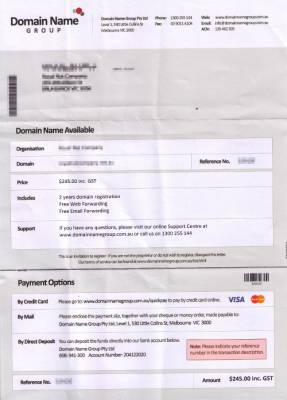If you are about to embark on creating a web presence for your business (or are still confused about what owning a website involves), read on!
There are essentially three elements essential to getting your business on the world wide web – and I have found it helpful to compare these elements to mobile phone setup:
Domain Name = this is similar to your mobile phone number
Web Hosting = this is similar to your mobile phone plan or package
Website = this is similar to your handset
As you would be aware, you need all three of those elements for your mobile phone to work. And in the same way, for your website to ‘appear’ you need a domain, a web hosting plan and of course, a website.
So here are each of those elements explained in more detail:
1. Domain Name
The very first thing you need to do is register a domain name. In fact, you can do this (and should do this) long before you plan to build a website. This is because the domain name you want may not be available, or may become unavailable if you wait too long. Domain names do not need to match exactly a business name, so for this reason, someone else may have already registered the one you want. In addition, there are some unscrupulous people who register domain names for existing businesses, for the purposes of selling it at an inflated price, or to just be annoying!
The process of registering a domain name is fairly simple. You need to find a domain registration company (registrar) at which to register and purchase your domain. All Australian domains (i.e those ending in .com.au) can only be registered for 2 years (no more, no less). Other domains (such as .com) have various registration periods, but always in increments of 1 or 2 years.
Most websites/companies that sell domain names require you to create an online account, check that your desired domain name is available, register your domain and pay for your domain online.
BUT BE WARNED!! Generally with pricing of domain names, you ‘get what you pay for’. Meaning that if you register your domain through a cheap domain company, it is highly likely that their prices don’t include services that are standard in more reputable companies. For example, one of the vital things you will need to do when you have a website ready to launch, is to access your domain’s ‘DNS records’, so that you can ‘point’ your domain to your hosting (see web hosting section below for more information on this). Many ‘cheap’ domain companies charge you extra to access this area, and you end up paying the same or more than higher priced domain companies.
Another consideration when choosing a domain registrar is whether this is a primary service that they offer. For example, most telecommunications companies in Australia also offer business services such as domain registration. What they DON’T tell you is that the domains are not actually registered through their company, so when you need to get support, make changes or transfer your domain, it can be extremely difficult to achieve those things.
Shel Design offers domain registration via a reputable domain registrar and our domain prices include access to all the areas you will require.
2. Website Hosting
Now that you’ve registered your domain, you will also need to purchase ‘web hosting’ if you want to have a website and/or set up emails using your domain name (e.g. This email address is being protected from spambots. You need JavaScript enabled to view it.).
Signing up for a web hosting account gives you access to a ‘server’ on which your website is stored (and hopefully backed up if you are using a reputable company!). When your web hosting account is created, you will be given the ‘domain name server’ settings that you will need to enter into your domain account. This ‘links’ your hosting to your domain.
Most web hosting companies provide you with an admin area called ‘cpanel’ (or similar). It is in this area where you can setup email accounts, check website traffic statistics and many other functions.
Shel Design recommends Crucial Web Hosting for a number of reasons:
- They are based in (Sydney) Australia.
- Their prices are very reasonable
- The hosting package includes 50GB storage, unlimited data transfer and unlimited email accounts.
- They provide automatic backups
- They guarantee 99.9% uptime
- The support they provide is comprehensive, fast and very helpful.
All of these aspects are VITAL elements for any web hosting that you choose. Please do not be tempted to choose a ‘cheap’ option that doesn’t offer all the above. I guarantee you will regret it in the long run, with a website that is often down due to poor uptime or low storage limits.
3. Website
There are many options for website design, and often it will be like comparing apples with oranges when you try to choose between various website design quotes! But here are some things that should be ‘non-negotiables’:
- Your website should be built using a Content Management System (CMS) as this will allow you to easily make changes to your site
- Any CMS system should be transferrable. That is, you need to ask the web designer if the CMS is owned by them or is ‘open source’. This is important, because if you decide you no longer wish to have this web designer look after your site and/or wish to transfer the site elsewhere, you will not be able to. The system, if owned by the website company, will likely only be able to be used while ever you continue to be contracted with that company. In addition, companies with their own CMS often charge higher hosting fees.
- I highly recommend you do not have your site built using ‘Flash’, as this is not compatible with search engines. That is, ‘Flash’ is essentially a collection of images, and search engines are unable to ‘read’ your site.
- Your web designer should be able to describe for you the ways that your site will be built to maximise Search Engine Optimisation (SEO). That is, it needs to be built in a way that allows for optimum chances for your site to rank well in search engine results. This should include the text you see on the page, as well ‘background’ text/keywords.
- Ideally, your quote for website design should also include: documentation or instructions for using your website; a specific list of inclusions (e.g. how many pages, forms, etc); whether there are limits on number of changes and drafts; prices for ongoing maintenance where required.
So now you are on your way! If you have any questions, you are welcome to email me at This email address is being protected from spambots. You need JavaScript enabled to view it.





 I know there are some of you who read this column who are not (yet) business owners, and who may be thinking about taking that leap of faith to launch your idea. If that’s you, have you considered the following?
I know there are some of you who read this column who are not (yet) business owners, and who may be thinking about taking that leap of faith to launch your idea. If that’s you, have you considered the following?

 Women who start their own business often enter pursuits that are male dominated – and being a business owner in general has traditionally been the realm of men.
Women who start their own business often enter pursuits that are male dominated – and being a business owner in general has traditionally been the realm of men. 1. Branding process
1. Branding process A few months ago I wrote an article (
A few months ago I wrote an article ( As Australians, we are known for having a bit of a whine about, well, almost everything! And the reality is, it is not hard to create a list of things that make operating a business in Australia a hard task.
As Australians, we are known for having a bit of a whine about, well, almost everything! And the reality is, it is not hard to create a list of things that make operating a business in Australia a hard task. Most businesses these days need to be innovative, often in the way they market their products, but also to promote growth, to attract the right staff and many other reasons. So being a ‘creative workplace’ is not limited to those of us in creative industries!
Most businesses these days need to be innovative, often in the way they market their products, but also to promote growth, to attract the right staff and many other reasons. So being a ‘creative workplace’ is not limited to those of us in creative industries!
 Most of us are aware of the pros and cons of working from home. And if you have been operating for any length of time, you will know how much hard work it is too. So here are some tips that will help you to maximise the positives:
Most of us are aware of the pros and cons of working from home. And if you have been operating for any length of time, you will know how much hard work it is too. So here are some tips that will help you to maximise the positives: My answer is: yes you should. Early on in my business, I learnt the hard way that I needed to listen to those niggly feelings. Too many times I listened to what seemed like the logical factors in a situation (all very valid factors), but failed to take notice of the unsettled feeling I had which I couldn’t necessarily explain.
My answer is: yes you should. Early on in my business, I learnt the hard way that I needed to listen to those niggly feelings. Too many times I listened to what seemed like the logical factors in a situation (all very valid factors), but failed to take notice of the unsettled feeling I had which I couldn’t necessarily explain. Domain Registration Letter/Invoice
Domain Registration Letter/Invoice Recently I phoned a day spa to make an enquiry about an appointment. What struck me about the staff member I was speaking to, was that she personified my expectations of a day spa. She spoke clearly and her manner was professional. She quickly established herself as knowledgeable about the services available by providing recommendations and being able to answer all my queries. The tone of voice she used was calming, and she established confidence that everything was being taken care of.
Recently I phoned a day spa to make an enquiry about an appointment. What struck me about the staff member I was speaking to, was that she personified my expectations of a day spa. She spoke clearly and her manner was professional. She quickly established herself as knowledgeable about the services available by providing recommendations and being able to answer all my queries. The tone of voice she used was calming, and she established confidence that everything was being taken care of.